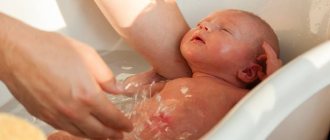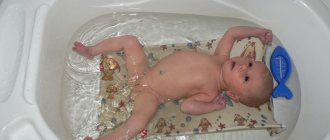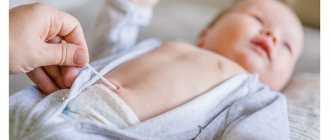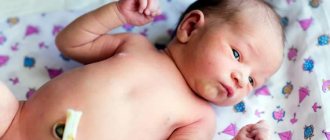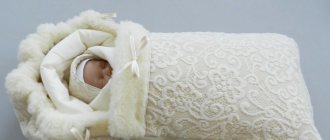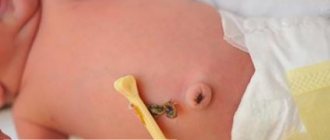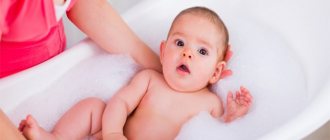In our culture, there is an immutable rule: a newborn must be bathed every day immediately after being discharged from the hospital. Where it came from and why it exists is a mystery, but observance of this ritual is considered absolutely mandatory.
In fact, the frequency of bathing depends entirely on all the participants, their mood and well-being. Newborn babies have very delicate skin, and tap water itself can dry out the skin of even adults. You can, of course, bathe your baby in boiled water, but this is too difficult to do and will quickly get boring for the whole family.
There are other circumstances that directly affect the need for bathing every day. For example, a mother is very tired in the evening, and she absolutely does not want to prepare a bath, bathe, soothe, put her to bed... Or the child himself ate and fell asleep, “not reaching” the evening bath. But you never know what can happen!?
When can you bathe a newborn after the hospital?
Now almost every sensation your baby experiences is new to him. But what he is already very familiar with is the pleasant and soothing feeling of immersing his body in a warm liquid. After all, this is exactly how he spent the previous nine months!
The child’s first bath can be organized even immediately after arrival from the maternity hospital; this will not cause the baby any discomfort. And even if the umbilical cord has not fallen off, there are no contraindications for water procedures - just remember to blot it dry after bathing.
How to properly bathe a newborn baby for the first time at home?
The main thing is not to worry and follow our instructions. Then the newborn’s first bath after the maternity hospital will go without problems, and each subsequent bath will bring only pleasure!
- Prepare a terry towel with a hood, as well as cosmetics, a diaper and things that you will change your baby into afterwards.
- Run a bath. Before the water has cooled, start bathing your newborn. For the first time at home, ask the baby's dad or other loved ones to insure you.
- Lower the child into the bath very slowly - first the legs, then the whole body.
- In the water, the baby's head and neck should be on your left wrist, and with the same hand you should hold the baby by the shoulder. If you are using a bathtub with a slide, place your baby on it.
- Gently wash the baby with your right hand and do not forget about the skin folds - you need to wash each one.
- Use shampoos and soaps no more than once a week.
- Bathe your baby for 5-10 minutes.
- Remove the child from the water, wipe his skin folds dry and lubricate them with moisturizing oil.
- Put a diaper on your baby.
- Put your baby in a sleepsuit and put him to sleep.
What should the water temperature be when bathing a baby for the first time?
In the 1st month of life, the baby is most comfortable swimming in water at 37 °C: it corresponds to the baby’s body temperature, so he does not freeze or overheat. To be completely sure that you did everything correctly, buy a special water thermometer. The popular method of checking the water temperature with your elbow is subjective and can be deceiving by several degrees in one direction or another.
In some sources you can find advice to bathe the baby in cooled boiled water for the first time after birth. You should only do this if you take water from an unreliable source, for example, from a well or shallow well. With central water supply, water undergoes preliminary treatment and must meet sanitary safety standards. In any case, if you have doubts about the quality of your water, take it to a laboratory for analysis.
How many times a week should you bathe your newborn?
A baby up to 6 months of age needs to be bathed every day. Water procedures remove impurities and wash away bacteria from the baby's skin, thereby significantly reducing the risk of diaper rash. After six months, you can reduce the number of baths to 2-3 per week.
Wash your baby with baby soap no more than once a week. For daily bathing, ordinary water is sufficient.
When is the best time to bathe a newborn?
Here everything is like for adults - it is best to swim before bed to wash away the dirt and worries of the past day. Water procedures relax the baby, promote quick sleep and comfortable sleep. It is advisable to bathe your child at the same time - this helps the baby develop a correct sleep-wake schedule.
As a rule, the mother begins to bathe the baby in the first days of life, and the question of the father’s participation in the process does not even arise. But in vain - nightly bathing helps dad establish close emotional contact with the baby. And, of course, end the day with the understanding of how infinitely insignificant all the problems are in comparison with the joy of fatherhood.
How to make your baby's first bath safe?
There are general safety rules that must be followed both when bathing a newborn for the first time, and during water procedures in adulthood. You'll soon learn them by heart, but during the first month, periodically refresh your memory of this list. Do not neglect the rules - your child’s health depends on them!
- Do not wash in a baby bathtub or use it for other unrelated purposes. The bath is for bathing only.
- When bathing in a regular bathtub, hold the baby's head to prevent it from submerging under the water. In a bathtub with a slide, the baby’s body is supported by the structure itself.
- To help parents of older children who are already bathing in a large bathtub, they produce special inflatable collars for water procedures. In such a circle around the neck, the child will be safe during the entire bath.
- Never leave your baby alone in the bathroom. This is dangerous not only for a helpless baby, but also for a grown-up toddler - in your absence, he may become interested in beautiful bottles with aromatic shampoos and gels and taste them.
- Many women love to take a bubble bath and from the first days strive to introduce their wonderful boy or beautiful girl to this pleasant procedure. Don't do this! Bath foam, even for children, worsens the protective properties of a child's skin and can cause an allergic reaction.
- Watch your child's reaction. If the water has cooled, the baby will try to curl up into a ball and may begin to tremble. Remove baby from the tub or tub, add hot water, stir, then continue bathing. If you make the water too warm, your baby will likely become lethargic and his skin will begin to turn red. Try not to go to either of these extremes.
- After bathing, the child's skin should be blotted with a towel, but not rubbed. And don't miss a single fold!
- After bathing your baby, you should not immediately dress your baby. It will be better if he lies down without clothes for several minutes - this way the baby’s body will dry better.
Bathing a newborn in the first month
In the first weeks of life, the baby requires special care and attention, because the child’s body is just adapting to new conditions. The baby should not be bathed in regular running water or in an adult bath until the umbilical wound heals. As a rule, this happens in the second or third week. During this period, the baby is bathed in a special baby bath or simply wiped with wet wipes.
In the first days of life, it is enough to wipe the baby with damp hypoallergenic wipes or a soft towel soaked in boiled water. Then you can start bathing your baby in the baby bath. In this case, too, only boiled water is used with a temperature of about 37 degrees above zero. The first baths should not exceed five minutes.
For bathing, rinse and prepare the bath. Pour in boiled water and wait until it cools to the desired temperature. Then undress the baby, hold him in your arms and press him to you. It is important that he calms down and knows that you are there. Immerse your baby in the water gradually and carefully.
Prepare a table in advance where you will dry your baby after bathing. Lay down a diaper or sheet, wrap the bathed baby in a warm terry towel. When drying your child, do not rub the skin, but lightly blot the moisture. Don't forget to treat the umbilical wound. To do this, blot your stomach with a towel or dry cloth. If there is still a clothespin on your belly button, carefully remove it. Dip a cotton swab in 3% hydrogen peroxide, carefully remove the crust and then thoroughly treat each area of the skin with peroxide.
The clothespin is also treated with peroxide and wiped dry with a cotton pad. Afterwards, it can also be treated with 70% alcohol to enhance protection against infections and bacteria. After the procedures have been completed, the clothespin is put back on. You can then lubricate your baby's skin with lotion or baby oil to moisturize and soften it. After this, they put on a diaper and clothes or wrap the baby in a diaper. Remember, it is not recommended to wear a diaper under a diaper!
Bathing a baby after a month
When the baby is 3-4 weeks old, you can start bathing the baby in a regular adult bathtub. However, it needs to be processed more carefully! But many parents prefer to use a baby bath even after a month. This is not surprising, because it is very comfortable. Plus it's more hygienic.
If you bathe your baby in an adult bath, you can use a children's slide or hammock. This will simplify the procedure, because the mother or father who is washing the baby will not have to bend too low towards the child. In addition, the baby, while in a hammock or on a slide, will not slide around the bathtub.
After a month, it is no longer necessary to boil water. The water temperature is reduced by one degree every week, and the bathing time is gradually increased to 15-20 minutes. The appropriate water temperature for a baby at one month is 36 degrees, at three months – up to 32 degrees.
For children older than two to three months, you can already practice special swimming exercises. This will further strengthen your muscles and immunity. The baby will not be afraid of water and will learn to swim faster. Thanks to a long evening bath, the baby will eat well before bed, fall asleep quickly and sleep peacefully the whole night.
You can bathe your child every day, and wash your child with soap and other products about once a week. It is important to wash every fold of the baby. It is better to water the child from a ladle. If the baby is afraid of water and is capricious, use various toys. They will help you relax and unwind, because bathing for a newborn can be stressful.
Safety precautions when bathing a child
It is important to pay attention to avoid drafts
Before you start swimming, you need to evaluate the air temperature in the room; if it is less than 25 degrees, then it is better to replace the procedure with simple wiping with a towel previously soaked in warm water. The fact is that an excessive temperature difference can lead to a cold, since the immune system has not yet adapted to the environment.
It is important to pay attention to ensure that there are no drafts. To do this, turn off fans, air conditioners and close all open windows. You should pay attention to the manicure; if it is very long, you can accidentally scratch the child’s delicate skin. For the same purpose, all jewelry is removed, as they can also damage the skin.
Such jewelry includes rings, bracelets, watches. For greater safety, it is necessary to bathe a newborn with the participation of two people. However, if this is not possible, then this procedure must be done carefully and slowly. If bathing is performed by one parent, then care must be taken in advance to ensure that everything is at hand.
The bathtub should be stable; it is advisable to place a rubber mat on the floor, as the water makes the floor slippery. You should not feed your baby before bathing; you can give him some water. Upon completion of the procedure, the child can eat with appetite. By following all these rules, you can protect yourself and your baby from unpleasant consequences.
About bathing a newborn from the mouth of a specialist:
Read: Champignons while breastfeeding: can I eat them?
27 Sep 2014 Yuki 439
Share this post
We recommend reading along with this article
- Positive and proper bathing of a newborn baby
- Feeding, sleeping, staying awake in the mode of a 2 month old baby
- Rules for caring for a newborn, carrying out the necessary…
- How to bathe a newborn baby correctly: basic rules
- How to properly care for a newborn baby, what should...
- How to make a children's room with a unique and inimitable design
- Features of the development of a newborn child by week, stages...
- If a newborn has trouble falling asleep, how can you help your baby?
- A stripe on the stomach during pregnancy: causes and ways to combat it
Beneficial properties of bathing
The washing procedure has a positive effect on the child’s health, strengthening him. The effect of this process is higher than that of using air baths. After all, the level of thermal conductivity of water exceeds the rate of heat energy transfer from air. The process of swimming stimulates the development of the vestibular apparatus. The baby, moving in the water, gets pleasure. At the same time, the muscular system further develops.
Bathing allows you to relieve muscle and emotional tension. If your baby suffers from abdominal pain associated with muscle colic, then an aquatic environment will help to endure the discomfort more easily. Indeed, in the initial stages of development, the problem of pain arises every day. In addition, with this procedure you can have a great time with your newborn, recharging yourself with positive emotions.
How often should cats be washed?
Despite the serious difference of opinion, experts recommend bathing cats periodically. To find out how often cats need to be washed, you should look at the conditions in which they are kept:
- A domestic animal that does not go outside needs bathing once a season.
- If cats live in urban environments, walk outside and return to the house, then they should be bathed more often - once every 1-2 months.
- A village animal that is allowed to roam everywhere only needs to be washed 3-5 times a year.
- Hairless breeds need to be bathed more often - every two weeks in the summer, every month in the winter.
How to bathe babies in the first month of life
Finally, the baby's umbilical wound has healed and he is allowed to bathe in a large bathtub filled with tap water. This process brings a lot of pleasure to the baby and his parents. The doctor will tell you how often to bathe a newborn baby up to a month old, but it is usually recommended to carry out such procedures every evening.
A large bath for a small child seems like a big sea. In the water, he can freely move his arms and legs and grab toys. Some parents use circles and caps that keep the baby's head above the water.
The water in the bath cools slowly, so water procedures can be easily extended for 20 minutes. While swimming, the baby spends a lot of energy and then sleeps peacefully until the morning. This procedure has a positive effect on metabolism and immunity, and the work of all internal organs and systems is activated. Water procedures are carried out sequentially.
- Wash the bath using baking soda or laundry soap. After using any detergents, rinse the bath thoroughly.
- Collect warm water, monitoring the temperature with a thermometer.
- Bright toys intended for swimming are placed in the water.
- The baby is carefully lowered into the water. This should be done slowly so that the baby does not get scared.
- A baby bathing ring is placed around the child's neck. With its help, the baby can safely swim in the bathtub.
Parents must monitor the newborn at all times; it is unacceptable to leave him alone even for a minute. After bathing, the circle is removed, the baby is pulled out and wrapped in a soft diaper. After drying the skin, the wet diaper is removed and the baby is wrapped in a towel. Clothes for dressing a newborn can be heated with an iron or placed on a radiator for a few minutes.

